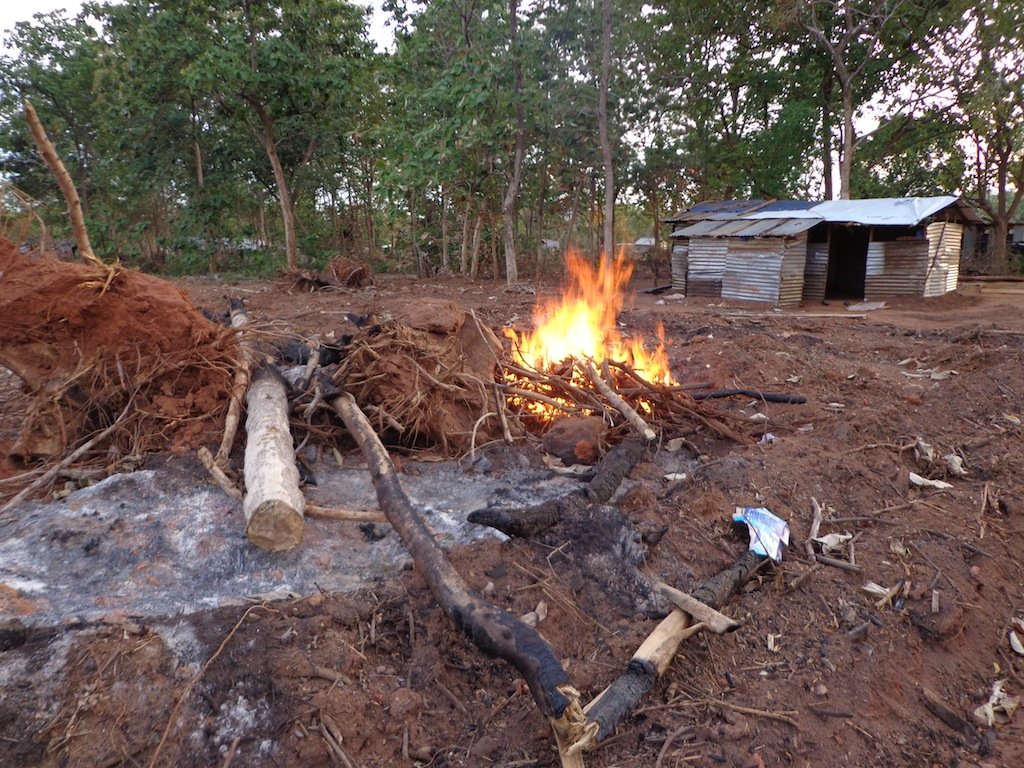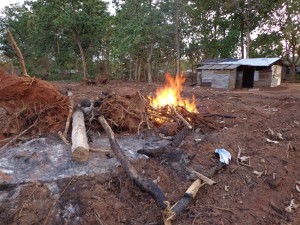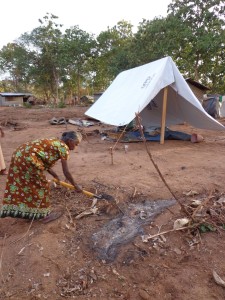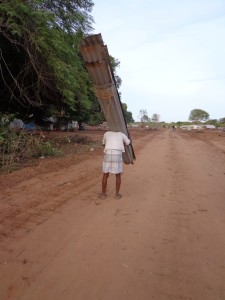“Why can’t the Army go to the jungles instead of taking our lands and sending us to jungles?”
“When will we be allowed to re-start cultivation of our lands?”
“When can we have access to the sea we were fishing before and will we get back the boats and fishing equipment we left behind in our village when we were displaced?”
“Why is there a check point at the entrance to this place?
“Why are there soldiers and intelligence officers all around us, why can’t we still have the freedom other people in this county have?”
“Why are visitors not allowed to come and freely talk to us and take photos?”
“Why have we been sent to another camp? What is different here from Menik Farm?”
“Why didn’t the authorities clean up the jungles before they sent us here?”
“When can we have a Kovil and Church?”
These were some of the questions that people who had fallen victim to the Sri Lankan Government’s latest resettlement program asked us when we visited them last Sunday 30th September 2012.
The bitter end to Manic Farm
Throughout August and September 2012, people from Puthukudiyiruppu and Maritimepattu Divisions in the Mullativu district, who had been living in Menik Farm were dumped in schools and roadsides to find their own way home[1]. “Home” was mainly shrub jungles, open air spaces under trees and destroyed houses with doors, windows, roofing, toilet equipment etc. looted. Some had to seek shelter in churches and schools, as their “home” was simply not habitable. Another group we met had been compelled to stay in a small church as the Army was occupying their land[2]. Clearly, the government which had waited for more than three years to send these people home, were now in a might hurry to send them home, without even clearing up jungles.
As news spread of imminent closure of Menik Farm at any cost, people in the Keppapilavu became apprehensive as they had heard that their lands were occupied by the Army and Air Force and they would not be allowed to go back to their own lands. On 20th Sept., about 55 families (exact number was not clear) from Manic Farm were taken to Vattrappalai school and brought to a jungle area in Seeniyamottai on 21st Sept. Amidst this uncertainty of going back home, several residents of Keppapilavu staged a protest in front of the Mullativu Government Agent’s office on 22nd Sept. There were reports of intimidation and attacks on vehicles of some politicians who attended this event[3]. Several IDPs in Manic Farm had also told that they were prevented from going for the protest. Those who did attend the protest sent out a public appeal asking to be allowed to go back home to their own lands[4].
On 22nd Sept. 2012, at a meeting held in Menik Farm, military and government officials had informed the remaining people that all those from Keppapilavu Grama Niladari Division in the Maritimepattu Divisional Secretarial Division in the Mullativu district would be relocated on 24th Sept. On 24th Sept., all these people were unceremoniously taken to Vattrappalai Maha Vidyalaya, and on 25th, they were taken to a jungle area called Seeniyamottai, located in an interior area along the Vattrappalai – Puthukudiyiruppu road, in the Maritimepattu Division in the Mullativu district.
According to information provided by a Government Official, 346 people from 110 families in Keppapilavu have been dumped in Seeniyamottai camp. This information has been confirmed by the UN Country Team in Sri Lanka[5]. However, according to the people we met, the number seems around 160 families, though this could not be confirmed by the people or any official.
Re-displacement instead of resettlement
But what is clear is that instead of being resettled, hundreds of families from the four villages of Keppaplavu, Sooriypuram, Pulakudirppu and Seeniyamottai have been re-displaced after being dumped to fend for themselves in what can only be called a most basic camp for internally displaced persons in the middle of a jungle. When we visited them people were still clearing up the area, some having been there about ten days and others five days. Fires to clear the shrub jungles were raging, some people were sweeping and others trying to put up temporary shelters. Some of the tarpaulin sheets put up had already been blown away. Army officers had helped build some temporary shelters for widows, but one widow showed us remains of one such temporary shelter damaged within few days. They showed us roofs that had been leaking when it was raining. The materials used, mostly damaged tin sheets salvaged after more than three years in Manic Farm by IDPs themselves, were simply not good enough to withstand heavy wind and rain in an open jungle. People complained of lack of toilets and water.
According people we met, they had very fertile land in Keppapilavu and Sooripuram and were living very happily, cultivating, fishing, with enough to income and enough to eat without depending on others. “Now they have made up paupers. We have to wait until they doll out rations that are of inferior quality and not enough”.
There were many complaints of “it was not like this in our village”. There were many wells in their villages, with many families having had their own well. And now there is severe shortage of wells and water. The wells in the new place also need to be much deeper than they had to be in their villages. People complained that there were less than 10 toilets for the hundreds of families. Parents complained that young children had to walk to Vattrappalai, a long way to go to school unlike in their village. There wasn’t a school or even a nursery nearby in the new place. While we were there, we heard the sound of “pooja” or “bana” over a loudspeaker and on inquiry, learnt that it was from the newly built temple in a nearby Army camp. There are only Hindus and Christians there, but no Kovil and Church nearby, like they had in their own villages.
Which brings us back to one of the questions put to us – why didn’t the government at least make basic arrangements like clearing the jungle, building adequate shelters with water and sanitation etc. over the last three and half years years if they had already decided to take these people’s lands and relocate these people here? Why had a process of consultation and discussion with affected people not initiated over the last three and half years?
The process of sending these people to Seeniyamottai is far from being voluntary and informed. If it can’t be termed forced, it is clearly bordering on forced, considering the coercive and threatening language used. Some of the threats were to deny them humanitarian assistance. Many we spoke to didn’t know where exactly they were going to be taken, what was there and what was not there and what was the longer term plan. Nor had they been asked for their views regarding possible alternatives.
Illegal land occupation by the Army and Air Force:
While the relocation process was clearly problematic, the crux of the problem was that these people’s lands have been or going to be occupied by the Army and the Air Force. As far back as 2010, we had seen large Army and Air Force camps boards marked “this land belongs to Air Force” along this road. Many of the people we met said they hold deeds to their lands. The extent of land belonging to a family seemed to vary between quarter acre to three acres based on people we talked to, although we were told some families had upto five acres. These are both residential and agricultural lands. Even those who didn’t hold deeds had been residing and cultivating for more than thirty years. Based on several land owners testimony, it was clear that the legal process of acquiring land has not been followed by the Army and the Air Force.
Based on available information from sources who do not want to disclose their identity, Keppapilavu consists of 528 acres of residential land and 684 acres of agricultural land, amounting to 1212 acres in total. Most of the residential land and some of the agricultural land is believed to be legally owned by private individuals who hold legal documentation.
Several people we met also accused the Army of cultivating and benefitting from their lands.
The Government has not transparently declare information about how many families had been in these villages at the time of displacement, how many had returned, how may had deeds, permits, grants and extent of land held by people as residential and agricultural lands.
Restrictions, threats and intimidation to journalists and visitors
The day before I went, I came to know that a visiting foreign journalist who was duly accredited through the Ministry of External Affairs and had Department of Information, was refused permission to enter the area despite having being told by the Military Spokesperson that he could visit and have access. At least two other English language journalists had been threatened, intimidated and asked not to enter the area, talk to people, take photos and report[6]. The Army had even lied to one of them and told to get permission from the District Secretary, who had made it clear that there was no need to get permission from him as he had not imposed any restrictions[7]. This made us think twice about going, but we decided to try our luck. But we did decided to leave a foreign friend who happened to be travelling with us behind in Puthukudiyiruppu, as there was no other place where she could wait for us amidst the military camps and jungles, and we didn’t want to lose the opportunity to visit these people because of an arbitrary “no foreigners” policy.
To reach the place, we had to take the dusty and bumpy Vattrappalai – Puthukudiyiruppu road. There was no sign board at the turn off into the small byroad and it was not easy to find, even though we had travelled on this road many times including even the previous week. It looks a good hide away. The whole place was heavily militarized. Just a few meters into the byroad, we were stopped at a military checkpoint and asked who we were, where we were going and why we were going there. After waiting for about five minutes, we were waved through, perhaps because of the Rev. Sister. But no sooner had we got off the van and started walking, two men in civil attire had landed out of nowhere and started to question our driver. They had claimed to be intelligence officers and had wanted to know who we were and about us. They had told our driver that they had strict instructions to collect details of those visiting these people, as the observations of these visitors might bring the government into disrepute internationally. Even as we sat talking to people in this new camp, we could clearly see these intelligence officers hovering around. As soon as they get close, the people we were talking would whisper “CID” (referring to officers of the Criminal Investigation Department) and change the topic. Some women told us that these CID officers would later ask the camp inmates who we were and what we asked and what they told us. Two widows who were very vocal an clearly angry about what had been done to them, told us that they had been instructed to tell anyone who asks that they are happy and provided all needs, and otherwise, there might be “trouble”. They appealed to us to tell their stories to the world outside without disclosing their names.
The beginning and memories of Menik Farm
This reflection about the end of Menik Farm would not be complete without mentioning about the beginning of Menik Farm. “Menik” means gem in Sinhalese. “Menike” is a popular Sinhalese name and “Menike” is also an affectionate name used to address someone lovingly or indicate value.
But the Menik Farm detention facility / IDP camp in Chettikulam, in Vavuniya district in Sri Lanka was far removed from these and was literally a “hell hole” for all those unfortunate to have found themselves confined there. Indeed, almost everyone was detained there against their will in the first 6-12 months and restrictions were imposed on freedom of movement even afterwards. Visitors could only go with special permission of the military. These restrictions were applied till the day it closed down on 24th Sept. 2012, after nearly 4 years.
In early 2008, I started to visit some people detained in two IDP camps in Kallimoddai and Sirukkadal in the Mannar district, where people fleeing LTTE controlled areas were detained[8]. Later, the same concept of detention was to be applied in Menik Farm. I first visited Menik Farm in early December 2008 when about 300 people who managed to escape the LTTE held areas were detained there[9]. Even at that time, access was heavily restricted and I was lucky to gain access thanks to a Catholic Priest who had got permission to go there to celebrate Mass. By the end of the war in May 2009, upto about 225,000 people were detained in Menik Farm[10] and conditions had become much worse. By this time, several friends of mine, including children, an elderly woman, Catholic Priests were detained there. I visited them often and was compelled to talk to them across the barbed wire fences. It was during this time that Sr. Nichola also started to visit Menik Farm, trying to console and assist families of those killed, disappeared, detained as well as those injured and traumatized. Being a member of the Clergy, she was able to obtain special permission which allowed her to go beyond the barbed wires – but that also only on Sundays. Till it was closed on 24th September 2012, we were still not allowed to freely enter Menik Farm. From 2010, we found it easier to meet it’s inmates after they were allowed some degree of freedom of movement and most started to go back to resettle in their own villages. Throughout these years, the stories we heard from Menik Farm were cries for those of loved ones killed, disappeared, detained, forcibly recruited, injured, lost properties, separated families etc. Menik Farm inmates had got there after spending months and months of multiple displacement, gradually abandoning their properties and belongings, spending long weeks and months hiding in bunkers without food, water, medicine, seeing their loved ones forcibly recruited, killed and injured in shelling, disappear after surrendering etc. In Menik Farm, they had survived restrictions on visits and travel outside, severe shortage of food, healthcare as well as natural disasters such as a cyclone[11] and floods[12].
To date, and to the best of our knowledge, the government had not explained under what law the Menik Farm inmates were detained and their freedom of movement restricted. Neither has there been any apology.
The future: more and more Menik Farms?
Closing down of Menik Farm after the forcible relocation of the last few hundred Menik Farm inmates due to illegal occupation of their lands is most likely due to upcoming Universal Periodic Review Process (UPR) of the UN Human Rights Council, where the Government would like to declare that Menik Farm is closed and there are zero IDPs in Sri Lanka. This was perhaps the inevitable end to an IDP camp which began by forcibly and illegally detaining people fleeing violence and war.
The new camp these people had been sent to has some alarming hall marks of Menik Farm, with restrictions on visitors, lack of preparation and even the most basic facilities.
Keppapilavu people in the Mullativu district now join those in the Jaffna high security zones, Mullikulam people in the Mannar district, Sampoor people in the Trincomalee district and several other lesser known areas[13], who continue to be IDPs due to occupation of their lands and villages by the Army, Navy and Air Force. Most of these appear to be illegal occupations, by passing existing laws.
Though the Chettikulam Menik Farm is closed, are we going to see more and more Menik Farms as people’s land continue to be illegally occupied by the military?
Authors: Ruki with Sr. Nichola Emmanuel
2nd October 2012
– GV



